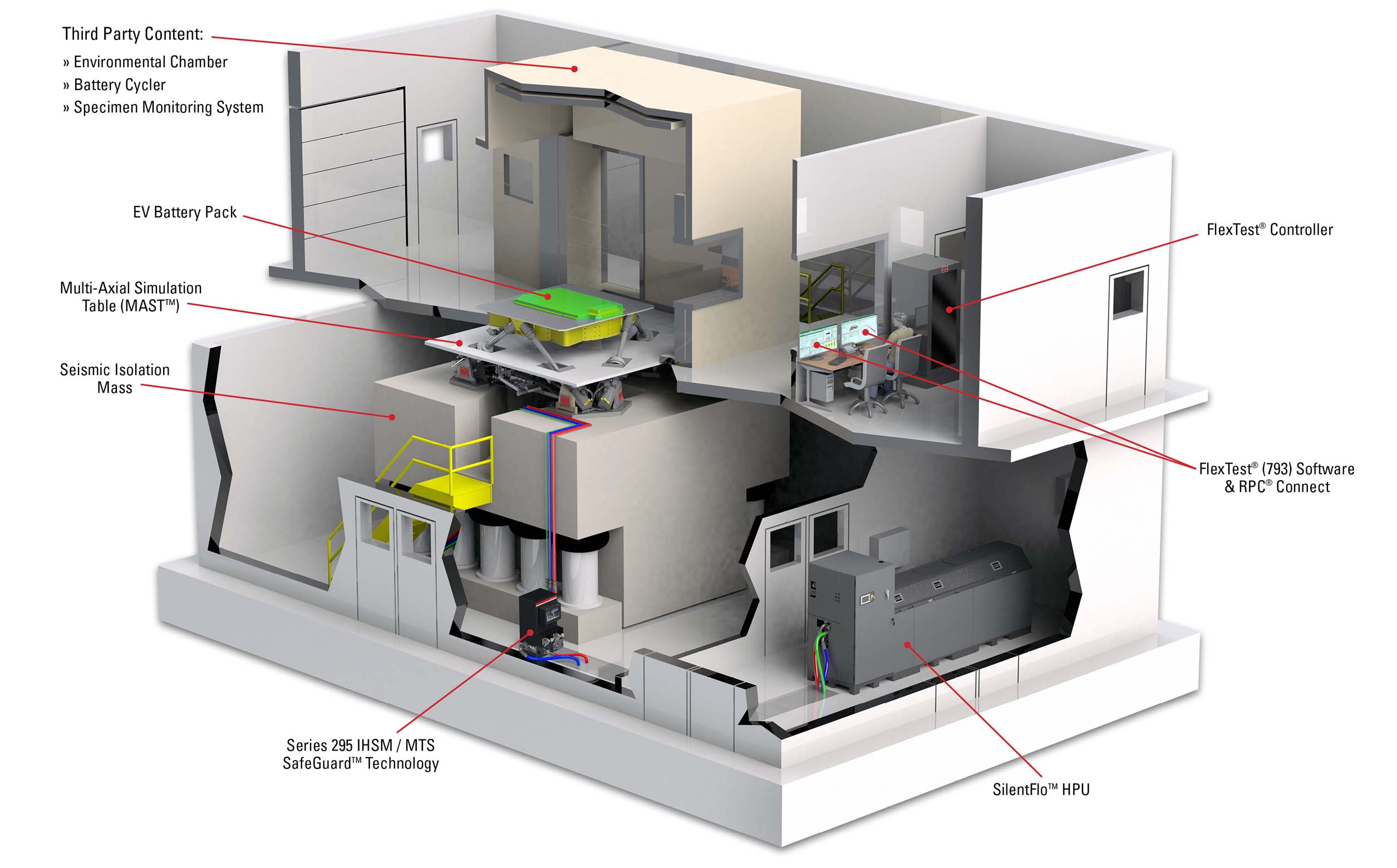EVバッテリー試験アプリケーション
電気自動車、トラック、オフハイウェイ車両、自転車、スクーター、全地形対応車両向けのリチウムイオンバッテリーおよびバッテリーパックの耐久性、性能、信頼性、品質を検証します。Technical Overview
ゼロエミッション電気自動車への世界的な動向により、リチウムイオンバッテリーの包括的なライフサイクル試験の需要が急速に高まっています。これらの試験は、新しい車両の実用性を確保するために必要な長距離走行を実現するために不可欠です。この試験は、サプライヤー、OEM、および契約試験ラボによって実施され、リチウムイオンバッテリーパックの耐久性、性能、品質、安全性を検証するために行われます。
試験方法
リチウムイオンバッテリーの振動試験プロファイルは、ISO 12405 をはじめとする国際規格、またはバッテリーサプライヤーやOEMによって定められています。試験プロファイルは、リチウムイオンバッテリー、バッテリーパック、または車両シャーシに搭載されたバッテリーパックを環境試験チャンバー内の振動テーブルに固定し、バッテリーサイクル装置や試験体監視技術と統合された状態で実施されます。振動は、まず垂直方向(Z)、次に横方向(Y)、最後に縦方向(X)の3つの空間方向に順次適用されます。振動試験の全過程において温度プロファイルが重ねられ、試験体の破損や電気接続の喪失が監視されます。他のリチウムイオンバッテリー試験規格には、SAE J2380、UN R100、UN R136、UN 38.3 などがあります。
試験結果
バッテリーサプライヤー、OEM、契約試験ラボは、振動試験結果をさまざまな目的で活用します。これには、バッテリーの耐久性や予想寿命の評価・検証、環境条件の範囲内でのバッテリー振動伝達特性、性能および信頼性の特性評価、そして製造されたバッテリーが厳格な品質基準を満たしているかを確認するエンド・オブ・ライン試験などが含まれます。
MTS製品ソリューション
-
多軸シミュレーションテーブル(MAST)システムは、国際的なバッテリー試験規格に適合するために必要な高周波数、大型ペイロードおよび幾何形状に対応できる標準およびカスタム構成で利用可能です。6DOF MASTシステムは、サードパーティ製の環境チャンバー、バッテリーサイクラー、試験体監視システムとのシームレスな統合を実現します。
- RPC Connectソフトウェアは、試験ラボの効率とスループットを最適化するために設計されています。実験室環境でのフィールド測定ロードを正確かつ効率的に再現し、実地試験の検証を管理された再現可能なラボ環境へと移行させます。
-
FlexTestコントローラーは、高速のクローズドループ制御、機能生成、トランスデューサー調整、およびデータ取得を提供します。FlexTest(793)ソフトウェアの高度な補正ツール(自由度制御、三変数制御、振幅位相制御、適応調和キャンセル)により、MASTシステムの制御性と忠実性を最高レベルに引き上げます。
-
シリーズ295アイソレーション油圧サービスマニホールド(ISHM)/MTS SafeGuard™ テクノロジーは、油圧システムの予測可能な制御を向上させ、ISO 13849 に準拠した高度な安全機能を実装し、地域の安全性能レベル(PLc、PLd、PLe)を満たします。
-
SilentFlo™ 515油圧パワーユニット(HPU)は、最先端のモーターと冷却回路を備え、高信頼性かつエネルギー効率の高い油圧パワーを生成します。SilentFlo HPUは、部品点数が少なく、操作しやすく、改良されたフィルター機能を備えているため、保守が容易です。


